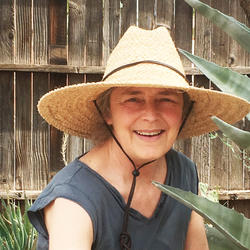Hope Leeson
As a botanist with nearly 30 years of field experience in southern New England, Hope Leeson’s feet and eyes have traveled over most of the state of Rhode Island. Her many years of determining where the edge of a wetland lies, and searching forests for rare and unusual plants, have contributed to her intimate knowledge of Rhode Island’s natural areas and plant communities. Her work experience has included employment for the Rhode Island Department of Environmental Management, United States Fish and Wildlife Service RI Refuge Complex and several environmental engineering firms. Additionally, she has consulted for the state’s non-profit organizations (Rhode Island Wild Plant Society, New England Wildflower Society, The Nature Conservancy-RI, Save the Bay and the Rhode Island Natural History Survey), documenting Rhode Island’s rare plant populations, native plant communities and invasive species, as well as providing public education on these topics.
Since 2008, as the botanist at the Rhode Island Natural History Survey, Leeson has applied her understanding of native plant communities and plant growth habits to the sustainable procurement of wild collected seed, native plant propagation and consultation with land managers for successful habitat restoration through the Rhody Native initiative.
She has been an adjunct faculty member at RISD since 2012, teaching on various botanical topics in the History, Philosophy and Social Sciences, and Landscape Architecture departments. In her spare time, she enjoys hiking and growing food and soil in her permaculture-based garden.
Courses
Fall 2023 Courses
LDAR 2252-01
PLANTS: BOTANY AND ECOLOGY
SECTION DESCRIPTION
This class will explore the botanical, horticultural and ecological aspects of plants and plant communities. Through lectures and field trips, students will become familiar with the form, physical qualities, identifying characteristics, seasonal aspect, preferred growing conditions, native habitats and ecological function of common plants of New England. In addition, lectures will focus on contemporary ecological theories around disturbance ecology and ecological succession to gain an understanding of how designers can work with these forces to shape landscapes over time.
Majors are pre-registered for this course by the department. Enrollment is limited to Landscape Architecture Students.
Major Requirement | MLA-I Landscape Architecture
LDAR 2252-02
PLANTS: BOTANY AND ECOLOGY
SECTION DESCRIPTION
This class will explore the botanical, horticultural and ecological aspects of plants and plant communities. Through lectures and field trips, students will become familiar with the form, physical qualities, identifying characteristics, seasonal aspect, preferred growing conditions, native habitats and ecological function of common plants of New England. In addition, lectures will focus on contemporary ecological theories around disturbance ecology and ecological succession to gain an understanding of how designers can work with these forces to shape landscapes over time.
Majors are pre-registered for this course by the department. Enrollment is limited to Landscape Architecture Students.
Major Requirement | MLA-I Landscape Architecture
Wintersession 2024 Courses
SCI W115-101
WINTER TREE WATCHING
SECTION DESCRIPTION
For much of the period of time we in the temperate regions of the northern hemisphere call winter, the trees around us appear lifeless. But are they? Dormancy in trees is a slowing of metabolic function, brought on and maintained by a combination of temperature and day length. Each species has a different response. The shortest day of the year marks a turning point for the plant world, as from that pivotal point day length steadily increases. So what are trees doing in January and February? In this class you will make daily observations and sketches of a single tree, from root to bud. Through daily observation and documentation you will really come to understand your tree and how its various parts function in all weather. Online class lectures on biological function will inform your observations. In addition, samples of a variety of species will be brought inside to observe their responses to warmer temperatures. Each species' response will be documented through sketches and measurements of change in bud size, and emersion of leaf and/or flower. By observing the response of different species to increases in ambient temperature, we will become more informed about the implications of dramatic fluctuations in winter temperatures for trees in the future.
Elective
Spring 2024 Courses
SCI 1085-01
UNDERSTANDING THE INTERCONNECTEDNESS OF NATURAL SCIENCES
SECTION DESCRIPTION
How do the soil, bedrock and water create habitat for living things? What are the roles that diverse living (and dead) organisms play in an ecosystem? We will explore the myriad of ways in which the natural sciences of geology, ecology, botany and zoology can inform our awareness of the world around us, including the problems we create in the environment. This course aims to show -- in lecture, lab and field -- how understanding basic natural sciences, and the connections they illuminate, can open our eyes to the natural diversity around us. Through careful observation, both during class and on their own, students will create ways to communicate the intricacy of these networks.
Elective
